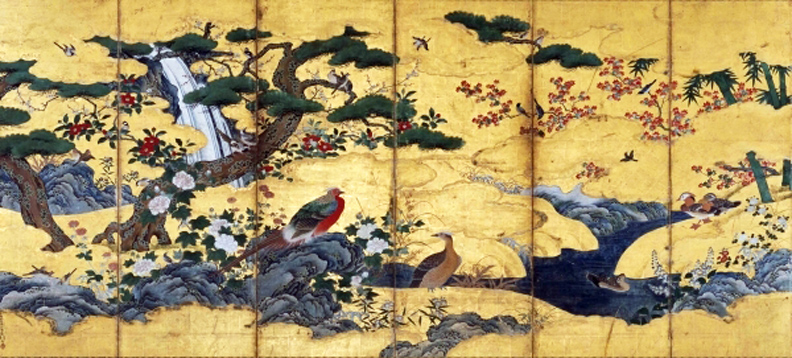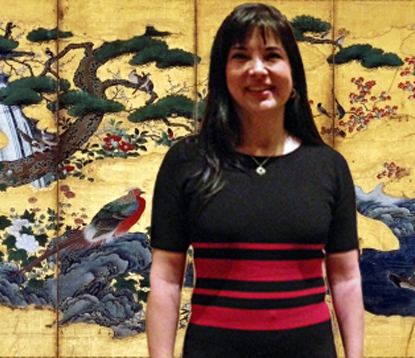
The Brandywine River Museum is deservedly famed for displaying three generations of art by the Wyeth family. In contrast, newly assembled at the Philadelphia Museum of Art are sixteen generations of art by the Kano family which dominated Japanese painting from the fifteenth century until the twentieth.
Nadine Kano is a descendant of this illustrious family. She grew up in the United States and was seeing most of this work for the first time as she and I walked through the galleries at Ink and Gold: Art of the Kano, taking photos with our iPhones.
It’s an unusual treat to accompany the heiress to such a legacy, and to see her personal delight. Most of this was new to her because she lives in the United States and 80% of these treasures were in private hands and had never left Japan.
Her family’s art was omnipresent when Japan was ruled by the shogunal and imperial families all the way to when Japan moved from being an isolated feudal society to a more modern form. It is the most enduring and influential school of painting in Japanese history. The Kano lineage was established by Kano Masanobu (1434-1530) who received commissions to create large-scale screens and sliding doors for royal residences, palaces and Zen temples. Succeeding Kano generations also were hired to design the homes and teahouses of wealthy merchants.
Then came a change in Japanese dynasties in 1912. Royal patronage ceased and her family members turned to other pursuits, such as tea farming. One of Nadine’s great-uncles showed promise as a painter but died at the age of sixteen. Her great-great grandfather, Kano Tomonobu, thus was the last of the lineage to practice art as a vocation.
Nadine grew up hearing about the long-ago exploits of her ancestors (such as the legend  that she was descended from a general who fought off Mongol invaders). But many art critics dismissed the legacy as too old and too traditional. With the cooperation and funding by the Agency for Cultural Affairs of Japan and the Tokyo National Museum, the Philadelphia Museum assembled 120 works, the largest-ever concentration of Kano art.
that she was descended from a general who fought off Mongol invaders). But many art critics dismissed the legacy as too old and too traditional. With the cooperation and funding by the Agency for Cultural Affairs of Japan and the Tokyo National Museum, the Philadelphia Museum assembled 120 works, the largest-ever concentration of Kano art.
Because the artwork is so fragile, the level of lighting is kept low, and the works will be rotated twice over the course of three months. (A side benefit of this, of course, is that the public can come back a second and third time and see completely new collections.) The media is ink and colors created from vegetables and minerals on silk or on paper, and is quite sensitive to light.
The oldest painting, near the entrance, is from before the time of Columbus’s first voyage to America. Subject matter includes landscapes, flowers, birds, trees, and mythological stories including dragons and phoenixes. As centuries passed, additional subjects appeared such as the sea and Mount Fuji.
Dynamic rocks and charismatic trees are prominent. The rocks appear stark, solid and formidable, while the trees are old and wise as they twist and envelope the things around them. The Kanos favored pine trees because of their longevity and stability. Starting in the middle period, some of the drawings and paintings are on gold leaf.
As we walked among the collection, Nadine told me “It’s overwhelming. It’s like visiting my family. Actually, it’s like attending a reunion where you meet some family members you never met before.”
She and I agreed on our favorite creation. It is a large six-panel folding screen that has pasted on its surface dozens of silk fans which were individually painted in many differing styles. She also loved an ink of a majestic dragon floating among the clouds.
The exhibit is perpetuated in a 350-page book published by the Museum in association with Yale University Press.
Read more reviews in The Cultural Critic.